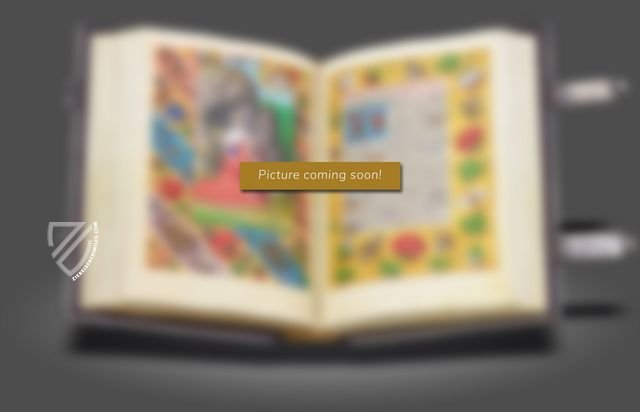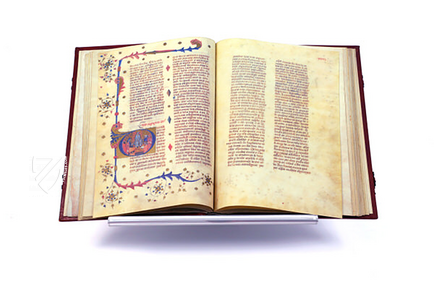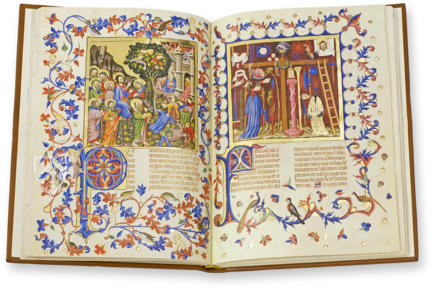Hours of Frederick of Aragon
(1,000€ - 3,000€)
Among the magnificent manuscripts created during the last phase of European book illumination, the Hours of Frederick of Aragon is considered to be truly exceptional. Work began on the manuscript in Naples ca. 1501, but King Frederick was forced to abdicate and go into a “gilded exile” in France. He had the manuscript completed in Touraine by a team of three artists in 1502: Jean Bourdichon, Ioan Todeschino, and the Master of Claude de France. The 62 full-page miniatures in the manuscript are the work of Bourdichon and are generally regarded as being his best work while Todeschino and the Master of Claude de France created the frames and bordures. These miniatures were first executed on fine parchment before being glued into the pages of the manuscript and integrated into the architectural frames. The result of this collaboration is one of the greatest masterpieces of Renaissance book art.
Hours of Frederick of Aragon
Described as a “particularly accomplished work of art” the Hours of Frederick of Aragon is one of the finest specimens of Renaissance book art to survive today. Aside from the typical texts found in a book of hours, the manuscript also contains pericopes of the Four Evangelists, the Hours of the Virgin, the Office of the Dead, the Penitential Psalms, and other liturgical texts. Unlike most books of hours, it does not have a calendar and Frederick’s coat of arms appears at the end of the codex instead of the beginning, which may have occurred when it was rebound during the 18th century.
It originated from the collaboration of three leading artists from the period and the sumptuous nature of its furnishings is an indication of the wealth of its royal patron, Frederick of Aragon (1452–1504), the last King of Naples from the Neapolitan branch of the House of Trastámara. Work on the manuscript was begun in 1501 and completed sometime in 1502. A scribe in Naples is believed to have executed the text in a humanist script before Frederick was deposed and forced to go into exile. Frederick brought one of his favorite artists, a Neapolitan named Ioan Todeschino (d. 1503), with him to France, where the illumination of the manuscript was completed.
Illuminated by an All-Star Team
In France, Todeschino worked in close collaboration with Jean Bourdichon (1457/59–1521) and the Master of Claude de France to create a work that bridges the gap between the French-Flemish tradition and the Venetian Renaissance. Bourdichon created the 62 full-page miniatures, which have been described as some of his best work. First pained on rectangles of thin parchment, they were glued onto pages in the book after their completion. Each miniature appears on the verso or left-hand page, accompanied by a richly decorated recto or right-hand side page with the text of a new section. They were then furnished by Todeschino and the Master of Claude de France with decorative frames that featured either floral ornamentation or classical elements such as pilasters, candelabras, precious stones, or imaginary figures in a distinctively Venetian-Paduan style.
A Life in Exile
Frederick became King of Naples after the death of his nephew and was crowned on the 26th of June 1497. However, the French Crown also had a claim on the kingdom, which was invaded in 1499. Although Frederick’s cousin Ferdinand II (1452–1516) came to his aid and drove out the French in 1501, Ferdinand retained the kingdom for himself and had Frederick deposed. Ironically, it was the King of France who offered Frederick a refuge and an annual annuity of thirty thousand pounds and thus he went into a “gilded exile” at the Château de Plessis-lez-Tours in the Loire Valley. It was there that he had this precious gem of book art illuminated, perhaps as a beautiful consolation prize for the loss of his kingdom.
The Road to Paris
As Frederick grew gradually poorer, he was forced to sell off much of his library to pay of debts in 1503. His wife Isabella del Balzo (1465–1533) inherited the rest of the collection, which then passed to her son Duke Ferdinand of Calabria (1488–1550). The Duke is believed to have brought the magnificent manuscript at hand to Spain, where it entered into the collections of the University of Valencia. It was one of five books bought by the Bibliothèque nationale de France in February of 1828 from an Englishman referred to as Monsieur Fergusson. At the time it already bore the stamp of Joseph Bonaparte (1768–1844), who had ruled as King of Naples from 1806 to 1808, but it is not known how he acquired the manuscripts nor how it came into the possession of Mr. Fergusson. One possible explanation is that the codex was taken as loot after the Battle of Vitoria in 1813 when some of the baggage of Joseph, then King of Spain, was seized by English troops. It was finally bought by the predecessor of today's Bibliothèque nationale de France, the French National Library, in 1828.
Codicology
- Alternative Titles
- Stundenbuch Friedrichs von Aragon
Libro de Horas de Federigo de Aragona
Horæ ad usum Fratrum Prædicatorum, dites Heures de Frédéric d’Aragon - Size / Format
- 388 pages / 24.5 × 15.5 cm
- Origin
- France
- Date
- 1501–1502
- Epochs
- Style
- Genre
- Language
- Script
- Humanistic
- Illustrations
- 64 full-page miniatures; 34 smaller miniatures
- Patron
- Frederick of Aragón (1452–1504)
- Artist / School
- Giovanni Todeschino
Jean Bourdichon
Master of Claude de France - Previous Owners
- Isabella del Balzo
Ferdinand, Duke of Calabria
Joseph Bonaparte, King of Naples
#1 Libro de Horas de Federigo de Aragona
Language: Spanish
(1,000€ - 3,000€)
- Treatises / Secular Books
- Apocalypses / Beatus
- Astronomy / Astrology
- Bestiaries
- Bibles / Gospels
- Chronicles / History / Law
- Geography / Maps
- Saints' Lives
- Islam / Oriental
- Judaism / Hebrew
- Single Leaf Collections
- Leonardo da Vinci
- Literature / Poetry
- Liturgical Manuscripts
- Medicine / Botany / Alchemy
- Music
- Mythology / Prophecies
- Psalters
- Other Religious Books
- Games / Hunting
- Private Devotion Books
- Other Genres
- Afghanistan
- Armenia
- Austria
- Belgium
- Colombia
- Croatia
- Czech Republic
- Denmark
- Egypt
- Ethiopia
- France
- Germany
- Hungary
- India
- Iran
- Iraq
- Israel
- Italy
- Japan
- Luxembourg
- Mexico
- Morocco
- Netherlands
- Peru
- Poland
- Portugal
- Russia
- Serbia
- Spain
- Sri Lanka
- Sweden
- Switzerland
- Syria
- Turkey
- Ukraine
- United Kingdom
- United States
- Uzbekistan
- Aboca Museum
- Ajuntament de Valencia
- Akademie Verlag
- Akademische Druck- u. Verlagsanstalt (ADEVA)
- Aldo Ausilio Editore - Bottega d’Erasmo
- Alecto Historical Editions
- Alkuin Verlag
- Almqvist & Wiksell
- Amilcare Pizzi
- Andreas & Andreas Verlagsbuchhandlung
- Archiv Verlag
- Archivi Edizioni
- Arnold Verlag
- ARS
- Ars Magna
- ArtCodex
- AyN Ediciones
- Azimuth Editions
- Badenia Verlag
- Bärenreiter-Verlag
- Belser Verlag
- Belser Verlag / WK Wertkontor
- Benziger Verlag
- Bernardinum Wydawnictwo
- BiblioGemma
- Biblioteca Apostolica Vaticana (Vaticanstadt, Vaticanstadt)
- Bibliotheca Palatina Faksimile Verlag
- Bibliotheca Rara
- Boydell & Brewer
- Bramante Edizioni
- Brepols Publishers
- British Library
- C. Weckesser
- Caixa Catalunya
- Canesi
- CAPSA, Ars Scriptoria
- Caratzas Brothers, Publishers
- Carus Verlag
- Circulo Cientifico
- Club Bibliófilo Versol
- Club du Livre
- CM Editores
- Collegium Graphicum
- Collezione Apocrifa Da Vinci
- Comissão Nacional para as Comemorações dos Descobrimentos Portugueses
- Coron Verlag
- Corvina
- CTHS
- D. S. Brewer
- De Agostini/UTET
- De Schutter
- Deuschle & Stemmle
- Deutscher Verlag für Kunstwissenschaft
- DIAMM
- Droz
- E. Schreiber Graphische Kunstanstalten
- Ediciones Boreal
- Ediciones Grial
- Ediclube
- Edições Inapa
- Edilan
- Editalia
- Edition Georg Popp
- Edition Leipzig
- Edition Libri Illustri
- Editiones Reales Sitios S. L.
- Éditions de l'Oiseau Lyre
- Editions Medicina Rara
- Editorial Casariego
- Editorial Mintzoa
- Editrice Antenore
- Editrice Velar
- Edizioni Edison
- Egeria, S.L.
- Eikon Editores
- Electa
- Enciclopèdia Catalana
- Eos-Verlag
- Ephesus Publishing
- Eugrammia Press
- Extraordinary Editions
- Fackelverlag
- Facsimila Art & Edition
- Facsimile Editions Ltd.
- Facsimilia Art & Edition Ebert KG
- Faksimile Verlag
- Feuermann Verlag
- Folger Shakespeare Library
- Franco Cosimo Panini Editore
- Friedrich Wittig Verlag
- Fundación Hullera Vasco-Leonesa
- G. Braziller
- Gabriele Mazzotta Editore
- Gebr. Mann Verlag
- Gesellschaft für graphische Industrie
- Getty Research Institute
- Giovanni Domenico de Rossi
- Giunti Editore
- Graffiti
- Grafica European Center of Fine Arts
- Guido Pressler
- Guillermo Blazquez
- H. N. Abrams
- Harrassowitz
- Helikon
- Hendrickson Publishers
- Henning Oppermann
- Herder Verlag
- Hes & De Graaf Publishers
- Hoepli
- Hortus Deliciarum
- Houghton Library
- Hugo Schmidt Verlag
- Idion Verlag
- Il Bulino, edizioni d'arte
- ILte
- Imago
- Insel Verlag
- Instituto de Estudios Altoaragoneses
- Instituto Nacional de Antropología e Historia
- Istituto dell'Enciclopedia Italiana - Treccani
- Istituto Ellenico di Studi Bizantini e Postbizantini
- Istituto Geografico De Agostini
- Istituto Poligrafico e Zecca dello Stato
- Italarte Art Establishments
- J. Thorbecke
- Jan Thorbecke Verlag
- Johnson Reprint Corporation
- Jugoslavija
- Karl W. Hiersemann
- Kasper Straube
- Kaydeda Ediciones
- Konrad Kölbl Verlag
- Kurt Wolff Verlag
- La Liberia dello Stato
- La Linea Editrice
- La Meta Editore
- Lambert Schneider
- Landeskreditbank Baden-Württemberg
- Leo S. Olschki
- Les Incunables
- Library of Congress
- Libreria Musicale Italiana
- Lichtdruck
- Lito Immagine Editore
- Lumen Artis
- Lund Humphries
- M. Moleiro Editor
- Maison des Sciences de l'homme et de la société de Poitiers
- Manuscriptum
- Maruzen-Yushodo Co. Ltd.
- MASA
- McGraw-Hill
- Militos
- Millennium Liber
- Müller & Schindler
- National Library of Wales
- Neri Pozza
- Nova Charta
- Oceanum Verlag
- Odeon
- Orbis Mediaevalis
- Orbis Pictus
- Österreichische Staatsdruckerei
- Oxford University Press
- Pageant Books
- Parzellers Buchverlag
- Patrimonio Ediciones
- Pattloch Verlag
- PIAF
- Pieper Verlag
- Plon-Nourrit et cie
- Prestel Verlag
- Princeton University Press
- Prisma Verlag
- Priuli & Verlucca, editori
- Pro Sport Verlag
- Propyläen Verlag
- Pytheas Books
- Quaternio Verlag Luzern
- Reales Sitios
- Recht-Verlag
- Reichert Verlag
- Reichsdruckerei
- Riehn & Reusch
- Roberto Vattori Editore
- Rosenkilde and Bagger
- Roxburghe Club
- Salerno Editrice
- Sarajevo Svjetlost
- Schöck ArtPrint Kft.
- Scolar Press
- Scrinium
- Scripta Maneant
- Scriptorium
- Siloé, arte y bibliofilia
- SISMEL - Edizioni del Galluzzo
- Sociedad Mexicana de Antropología
- Sorli Ediciones
- Stainer and Bell
- Styria Verlag
- Sumptibus Pragopress
- Szegedi Tudomànyegyetem
- Taberna Libraria
- Tarshish Books
- Taschen
- Tempus Libri
- Testimonio Compañía Editorial
- Thames and Hudson
- The Clear Vue Publishing Partnership Limited
- The Facsimile Codex
- The Folio Society
- The Marquess of Normanby
- The Richard III and Yorkist History Trust
- Tip.Le.Co
- TouchArt
- TREC Publishing House
- TRI Publishing Co.
- Trident Editore
- Typis Regiae Officinae Polygraphicae
- Universidad de Granada
- University of California Press
- University of Chicago Press
- Urs Graf
- Vallecchi
- Van Wijnen
- VCH, Acta Humaniora
- VDI Verlag
- Verlag für Regionalgeschichte
- Verlag Styria
- Vicent Garcia Editores
- W. Turnowsky
- Wiener Mechitharisten-Congregation (Wien, Österreich)
- Wissenschaftliche Buchgesellschaft
- Xuntanza Editorial
- Zollikofer AG





